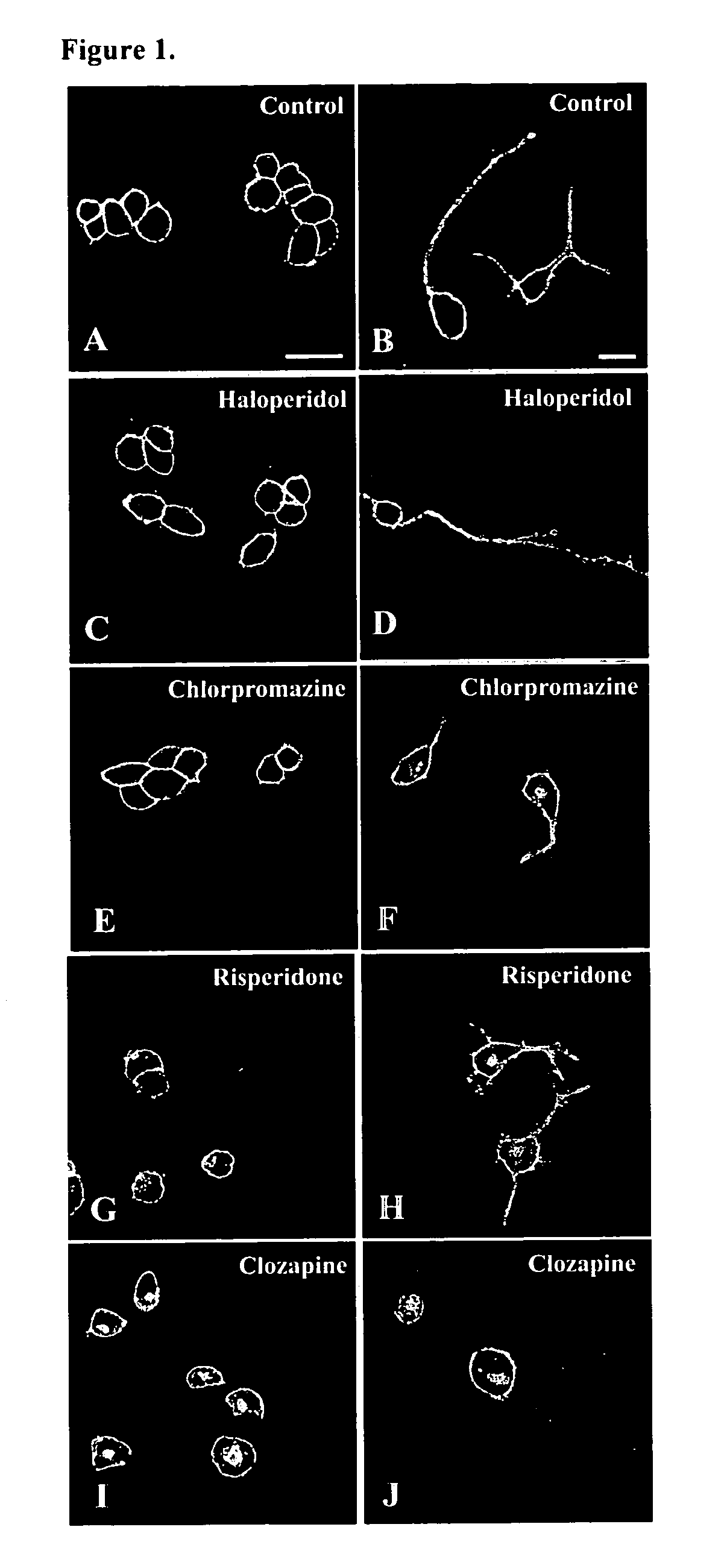Novel assay for screening antipsychotic drugs
a technology of antipsychotic drugs and assays, applied in the field of new assay methods for the screening of antipsychotic drugs, can solve the problems of no available in vitro assays available to screen antipsychotic drugs, and no data exists to provide such predictions, and achieve the effect of easy observation
- Summary
- Abstract
- Description
- Claims
- Application Information
AI Technical Summary
Benefits of technology
Problems solved by technology
Method used
Image
Examples
example 1
[0050] Generation of SR2-GFP receptor and HEK293 cells stably expressing SR2-GFP receptors: Enhanced green fluorescence protein (EGFP) had been tagged at the C-terminus of the full-length rat 5-HT2A receptor (SR2-GFP) and a stable line, SB-1, expressing fluorescent SR2-GFP receptors was established in the HEK293 cell line. The 1.8 kb cDNA fragment containing the entire rat 5-HT2A receptor-coding region was obtained from the plasmid pSR2 by PCR using two primers. The forward primer contained the EcoR1 site and the coding sequence of the first few amino acids encoding the receptor. The reverse primer contained the non-coding strand sequence of the last few amino acids of the receptor followed by a BamH1 site which when cut and cloned into the EcoR1 BamH1 double-digested pEGFP-N1 vector from Clontech, USA resulted in the coding region of the receptor being in frame with the EGFP coding region. The entire segment that was cloned into the vector was sequenced to ensure that mutations in ...
example 2
[0051] Generation of HEK293 cell lines with stable expression of SR2-GFP: HEK293 cells were maintained in Dulbecco's Modified Eagle medium (DMEM) supplemented with 10% fetal calf serum, penicillin (100 IU / ml) and streptomycin (100μg / ml) at 37° C., 5% CO2. Cells were grown to 65-70% confluency in 35 mm dishes and transfected with 2 μg of SR2-GFP DNA using 10 μg of lipofectamine in 1 ml OptiMEM. After 2 days in culture, cells were selected with 1 mg / ml of the neomycin analogue G418 and 30 stable lines (SB series) expressing varying amounts of SR2-GFP receptors, as determined through fluorescence expression, were established. All further experiments were conducted with two of these lines—SB-1 and SB-2, which expressed high and medium levels of the fusion receptor, respectively.
example 3
[0052] Construction of the Myc 5-HT2A fusion receptor: To tag Myc at the N-terminus of the full-length rat 5-HT2A receptor, the entire rat 5-HT2A coding region was obtained by PCR using SR2-GFP DNA as the template. The upper primer contained the ScaI restriction enzyme site and the lower primer had the stop codon and the BglII restriction enzyme site. The PCR product was then digested with ScaI and BglII restriction enzymes. To clone this insert into the pCruz-MycA vector obtained from Santa Cruz, USA. pCruz-MycA plasmid DNA was digested with the ScaI and BglII restriction enzymes. The digested PCR product was then ligated into the digested vector DNA using the E. coli T4 DNA ligase. The ligated mix was then transformed in DH5α competent cells using kanamycin as the selection antibiotic. Plasmid DNA was isolated from individual colonies and presence of the insert was confirmed by restriction enzyme digestion. The entire cloned region was then sequenced to ensure that the Myc-5-HT2A ...
PUM
| Property | Measurement | Unit |
|---|---|---|
| volume | aaaaa | aaaaa |
| volume | aaaaa | aaaaa |
| fluorescent | aaaaa | aaaaa |
Abstract
Description
Claims
Application Information
 Login to View More
Login to View More - R&D
- Intellectual Property
- Life Sciences
- Materials
- Tech Scout
- Unparalleled Data Quality
- Higher Quality Content
- 60% Fewer Hallucinations
Browse by: Latest US Patents, China's latest patents, Technical Efficacy Thesaurus, Application Domain, Technology Topic, Popular Technical Reports.
© 2025 PatSnap. All rights reserved.Legal|Privacy policy|Modern Slavery Act Transparency Statement|Sitemap|About US| Contact US: help@patsnap.com


